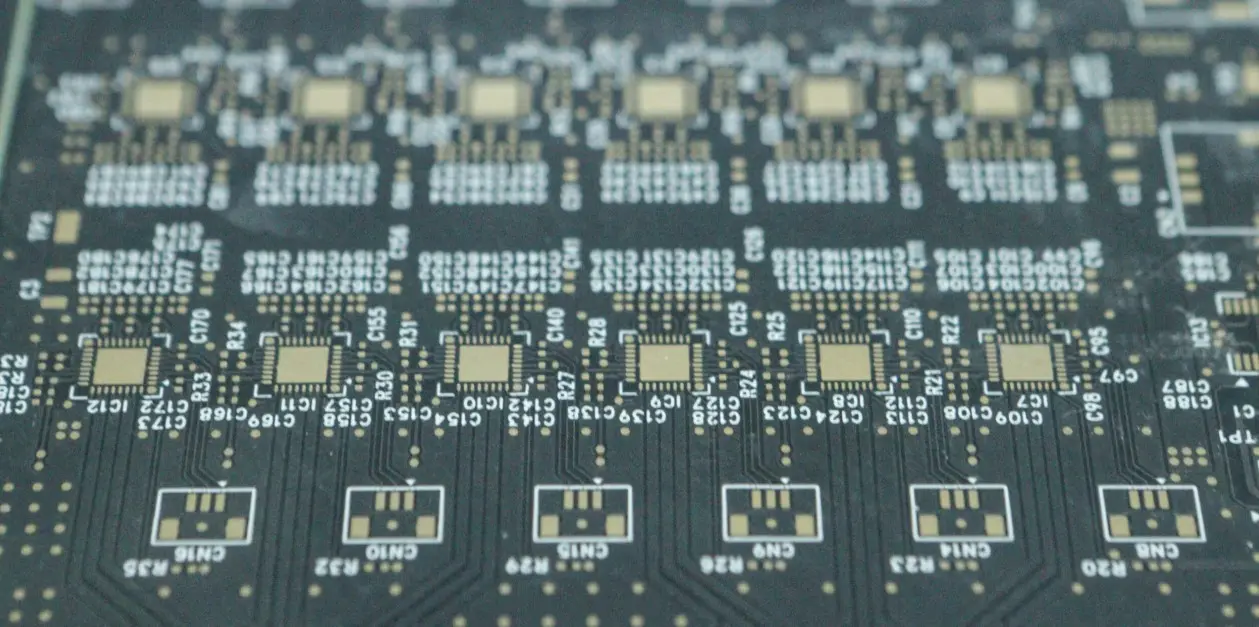Professional FR4 PCB Manufacturer
Highleap provide good quality FR4 PCB manufacture up to 60 layers, whether prototype or mass production.
What is FR4 PCB?
FR4 is a common dielectric material used in printed circuit boards. It stands for fiberglass-reinforced epoxy-laminated sheets, providing mechanical support and separating copper layers.
The “FR” in FR4 indicates flame retardant, meeting UL94V-0 standard for inflammability. It prevents fire expansion and ensures immediate extinguishing when burning.
A print circuit board with FR4 is called the FR4 PCB.The FR4 sheets are combined with copper layers on both sides to form a Copper Clad Laminate (CCL). FR4 provides strength and durability to PCB boards, making them reliable for various applications.

Properties of FR4 PCB
Why choose FR4 material as material for your PCB project? The following may be the answer.
Flame Retardant
FR4 is the standard material for PCBs, known for its fire-resistant properties. It consists of a fiberglass-reinforced epoxy laminate with Bromine, a halogen element known for flame-retardant characteristics. This combination helps prevent or delay fire spread during electrical faults.
Low-Cost
FR4 material offers a cost-effective solution for a wide range of applications. However, it’s important to note that FR4 materials with specific properties such as a high glass transition temperature or high comparative tracking index may come at a slightly higher price.
Load Bearing
As we know that FR4 is a combination of fiberglass and epoxy resin, and it provides high load-bearing capacity and mechanical strength to the overall PCB.
But mainly, the strength and load bearing depend on the thickness of the material. The thickness of a standard FR4 material varies between 0.2 to 3.2m
Higher Glass Transition Temperature
FR4 pcb is known for its high temperature resistance, typically offering a Tg (glass transition temperature) value of 150°C or 170°C.
By using FR4 with a high Tg value, manufacturers can ensure that their PCBs can withstand higher temperatures, resist moisture absorption, and exhibit enhanced chemical resistance.
Excellent Electrical Properties
The FR4 is used as the base material which makes its electrical properties important to be noticed. As the electrical properties of a PCB material are crucial for signal integrity, impedance control, and the quality of insulation.
However, FR4 isn’t the best material for high-frequency applications since it has a more wondrous Df (dissipation factor) than high-frequency materials.
High Dielectric Strength
FR4 material provides high dielectric strength somewhere between 4.25-4.55.
However,FR4 does not offer uniform dielectric constant like high-speed board materials.As the frequency goes up the Dk varies. Dielectric constanttolerances for high-speed materials are less than 2%, whereas for FR4 it is up to 10%.
Moisture Resistant
FR4 PCBs have excellent moisture resistance, making them ideal for various applications, even in humid and marine environments. Manufacturers enhance moisture resistance through techniques like protective coatings and moisture-resistant additives.
Higher Decomposition Value
The decomposition temperature (Td) defines the temperature where a PCB’s almost 5% of the laminate’s mass is lost due to decomposition. FR4 PCB material provides a higher decomposition temperature of 345 Celsius.

Searching FR4
PCB Supplier?
Being a trusted rigid fr4 printed circuit board manufacturer with a vast industry experience, we specialize in all kinds of printed circuit boards.
Are you searching for a manufacturer to meet your PCB needs? Look no further than Highleap!
Types of FR4 PCB
Fr4 can be roughly divided into the following types, please choose the appropriate fr4 type according to your needs.
Standard FR4 PCB
Standard FR-4 refers to the normal material, with heat resistance ranging from 150-160 Celsius. The properties and advantages of the standard FR-4 are listed above.
High TG FR4 PCB
High TG FR4 refers to a base material with a high glass transition temperature, allowing PCBs to withstand 170℃. Standard FR4 is a good insulator and flame retardant, but its insulating properties may weaken under high power, voltage, or heat. High TG materials are used to avoid such issues.
High CTI FR4 PCB
The Comparative Tracking Index (CTI) measures an insulating material’s resistance to current flow between tracks on a PCB. A high CTI value, up to 600 volts, indicates greater resistance to harsh environmental and electrical conditions.
FR4 PCB with no laminated Copper
This type of FR4 pcb is a little different with distinct functions. As the name itself explain that this type of material has no copper lamination on it and, therefore, is used to insulate and support other boards, etc.
Manufacturing Suggestions
When you hesitate whether to use Fr4 as the base material of pcb, you need to consider the following points:
Thickness and Weight
FR4 PCB sheets can range from 0.127 mm to 3.175 mm (0.005 inches to 0.125 inches), tailored to project requirements.Thin boards offer a lightweight advantage, perfect for consumer electronics and cost-efficient shipping.
But for larger dimensions, caution against potential fractures and bending. Likewise, while thicker boards provide durability, their added weight might affect the module/device’s performance.
Flexibility Options
When assessing the thickness of FR-4 PCB material, flexibility becomes a critical factor. Thinner boards offer enhanced flexibility, although the risk of bending and angle alteration increases during soldering due to heat. Managing heat is paramount in such designs.
Furthermore, flex PCBs exhibit commendable performance in applications involving consistent stress and flexibility. Their versatile utility spans across various sectors, including medical and automotive devices.
Controlled Impedance
High-frequency/high-speed boards need controlled impedance, which relies on stable dielectric constant (Dk) and low thermal coefficient of dielectric constant (TCDK). Balancing FR4 material thickness is crucial. Thin PCBs face increased TCDK and fluctuating Dk due to high heat, so maintaining thickness is vital to achieve a low dielectric constant (Dk).
Temperature Resistance
FR4 exhibits a low level of thermal conductivity, causing heat to disperse slowly. Consequently, heat dissipation poses a challenge in FR4 printed circuit boards, limiting their tolerance for higher temperatures, exceeding 170 ℃.
In scenarios demanding remarkable temperature resistance, metal core PCB emerge as optimal choices.
Lead-Free Soldering
Standard FR-4 material has a low glass transition temperature. While lead-free soldering requires a higher melting point. In this case, standard FR-4 PCB material is preferred to avoid while high TG FR-4 material could be used.
Start Your FR4 PCB Project!
Highleap specializes in the FR4 PCBs manufacturing more than 10 years.We have a strong capacity and can produce various FR4 PCBs.Send your request now!
Capabilities of Manufacturing
We provide the PCB in various surface finishing options,such as
- Gold Fingers
- HASL (Hot Air Solder Leveling)
- ENIG (Electroless Nickel immersion Gold)
- OSP (Organic Solderability Preservatives)
- Immersion silver
- Immersion tin,and so on
The boards are available in all leading solder mask colors, such as white, blue, black, green, and red.
Items
Capabilities
Choose Highleap as Your PCB Manufacturer

Full Expertise
We have rich experience in all kinds of PCB manufacturing and assembly.From component procurement to product delivery, we can complete every step with high quality.

Strong Supplier Network
With 10 years of experience in the PCB industry, Highleap owns a supplier network that provides us with reliable access to get high-quality components at competitive prices.

Strict Quality Control
At each process, we strictly control the quality by implementing a variety of testing and inspections to ensure that each PCBA reaches the highest quality standard.
Take a Quick Quote
Discover how our expertise can help with your next PCB project.
